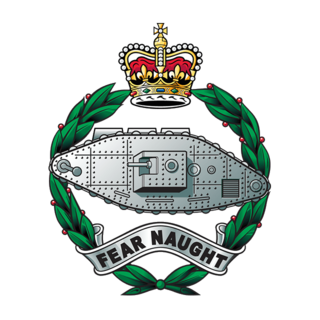
The Royal Tank Regiment (RTR) is the oldest tank unit in the world, being formed by the British Army in 1916 during the First World War. Today, it is the armoured regiment of the British Army's 12th Armoured Infantry Brigade. Formerly known as the Tank Corps and the Royal Tank Corps, it is part of the Royal Armoured Corps.

The King's Own Calgary Regiment (RCAC), (The King's Own or The KOCR), is a Canadian Army armoured reconnaissance regiment of the Canadian Armed Forces Primary Reserve. Headquartered at the Mewata Armoury in Calgary, Alberta, the KOCR is a part-time reserve unit of 3rd Canadian Division's 41 Canadian Brigade Group. Its regimental museum is located in Calgary.
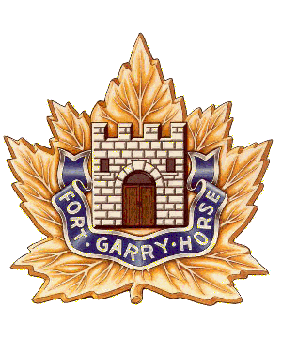
The Fort Garry Horse is a Canadian Army Reserve armoured regiment based in Winnipeg, Manitoba, Canada. It is part of 3rd Canadian Division's 38 Canadian Brigade Group. It traces its history to a cavalry regiment first formed in 1912 that first took up the name "Fort Garry" a year afterwards. Since that time the regiment has served in the First World War, sending men to battalions of the Canadian Expeditionary Force, and as an armoured regiment in the Second World War.

The Royal Canadian Armoured Corps is the armoured corps within the Canadian Army, including 3 Regular and 18 Reserve Force regiments, as well as the Royal Canadian Armoured Corps School.

The Ferret armoured car, also commonly called the Ferret scout car, is a British armoured fighting vehicle designed and built for reconnaissance purposes. The Ferret was produced between 1952 and 1971 by the UK company Daimler. It was widely used by regiments in the British Army, as well as the RAF Regiment and Commonwealth countries throughout the period.

The Fox Armoured Car was a wheeled armoured fighting vehicle produced by Canada in the Second World War.

The Tank Museum is a collection of armoured fighting vehicles at Bovington Camp in Dorset, South West England. It is about 1 mile (1.6 km) north of the village of Wool and 12 miles (19 km) west of the major port of Poole. The collection traces the history of the tank. With almost 300 vehicles on exhibition from 26 countries it is the largest collection of tanks and the third largest collection of armoured vehicles in the world. It includes Tiger 131, the only working example of a German Tiger I tank, and a British First World War Mark I, the world's oldest surviving combat tank. It is the museum of the Royal Tank Regiment and the Royal Armoured Corps and is a registered charity.

The Ontario Regiment (RCAC) is a Primary Reserve armoured reconnaissance regiment of the Canadian Army. The unit is based in downtown Oshawa, Ontario, and is named after Ontario County (1852–1973). Formed in 1866, and more commonly known as the 'Ontarios', 'black cats' or 'ONT R' (pronounced "ON-tar"), the regiment ranks among the oldest continuously serving Reserve (Militia) regiments in Canada and is one of the senior armoured regiments in the Royal Canadian Armoured Corps.
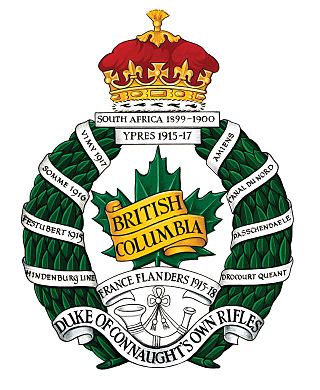
The British Columbia Regiment (Duke of Connaught's Own) is a Primary Reserve armoured reconnaissance (recce) regiment of the Canadian Army; the regiment is subordinate to 39 Canadian Brigade Group of the 3rd Canadian Division. Established in 1883, it is the oldest military unit in Vancouver, British Columbia, Canada. It parades at the Beatty Street Drill Hall at the corner of Dunsmuir and Beatty in Downtown Vancouver. The regiment has been variously designated as garrison artillery, rifles, infantry, and armoured, but has been reconnaissance since 1965. It has received 41 battle honours in its history, and has been a unit of the Royal Canadian Armoured Corps since 1942.
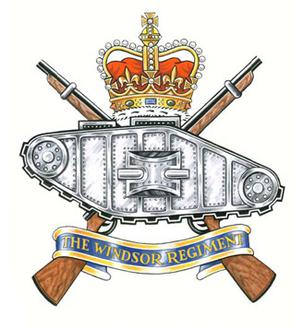
The Windsor Regiment (RCAC) is a Primary Reserve armoured regiment of the Canadian Army, based in Windsor, Ontario and is part of the 4th Canadian Division's 31 Canadian Brigade Group.
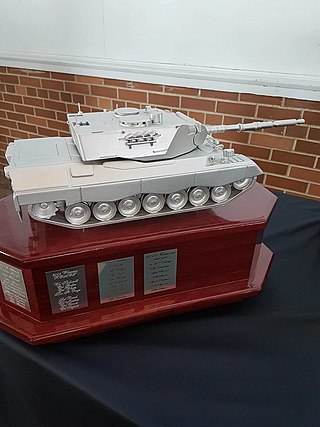
The Worthington Trophy is a Canadian military award. It was awarded annually to the best reserve armoured unit in the Canadian Land Forces. It is named after Major-General F. F. Worthington, known as Fighting Frank – "The Father of the Royal Canadian Armoured Corps".

The M4 Sherman tank was produced in several variants, a result of mass production spread across several manufacturers and several years. It was also the basis for a number of related vehicles and Shermans have been modified by several nations, ranging from upgrades to complete hull conversions for another task. Originally designed in 1941, M4 variants were still used by Israel during the 1967 and 1973 wars with its Arab neighbors.

This article deals with Sherman tanks extensive use around the world after World War II and catalogues foreign post–World War II use and conversions of Sherman tanks and variants based on the Sherman chassis.

The United States provided tens of thousands of its Medium Tank M4, also named the Sherman, to many of its Allies during the Second World War, under the terms of Lend-Lease.

The Lynx reconnaissance vehicle is a United States-built tracked reconnaissance armoured fighting vehicle, which was employed by the armed forces of the Netherlands and Canada. Dutch vehicles were exported in the 1990s to Bahrain and Chile, according to SIPRI 150 and 8 vehicles respectively.
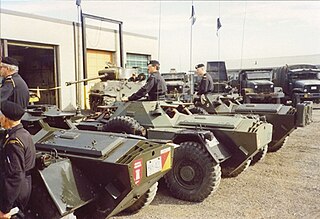
The Oshawa Military and Industrial Museum, also known as The Ontario Regiment (RCAC) "Ferret Club," is an accredited Canadian Forces Museum located in Oshawa, Ontario, Canada. Founded in 1980, it has evolved into the Historic Vehicle Section of the Ontario Regiment Museum.

Armoured reconnaissance is the combination of terrestrial reconnaissance with armoured warfare by soldiers using tanks and wheeled or tracked armoured reconnaissance vehicles. While the mission of reconnaissance is to gather intelligence about the enemy with the use of reconnaissance vehicles, armoured reconnaissance adds the ability to fight for information, and to have an effect on and to shape the enemy through the performance of traditional armoured tasks.
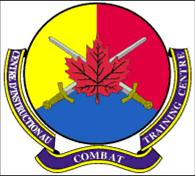
The Combat Training Centre is responsible for the individual training of Canadian Army soldiers and officers in military occupational classifications that are controlled by the Canadian Army. The centre is headquartered at the 5th Canadian Division Support Base Gagetown, New Brunswick, and maintains schools at CFB Kingston, 8 Wing Trenton and CFB Borden in Ontario. Originally known as the Combat Arms School, it was formed at Camp Borden, Ontario, in 1965, moving to CFB Gagetown in the early 1970's. It is a formation of the Canadian Army Doctrine and Training Centre, the former Land Force Doctrine and Training System which was renamed as part of the reorganization of the Canadian Army on 18 July 2013.

The Australian Armour and Artillery Museum is a privately owned museum dedicated to tanks, armoured vehicles and artillery from the Second World War and post war periods. It was officially opened in 2014, in Cairns, Queensland, Australia.
























